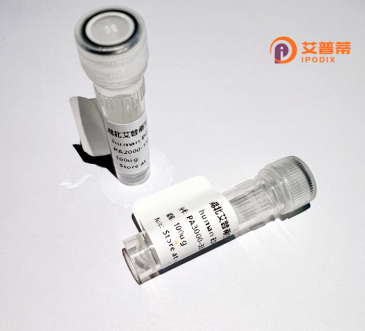
| 纯度 | >90%SDS-PAGE. |
| 种属 | Human |
| 靶点 | LOC143241 |
| Uniprot No | 0 |
| 内毒素 | < 0.01EU/μg |
| 表达宿主 | E.coli |
| 表达区间 | 1-177aa |
| 活性数据 | MESIYLQKHLGACLTQGLAEVARVRPVDPIEYLALWIYKYKENVTMEQLRQKEMAKLERERELALMEQEMMERLKAEELLLQQQQLALQLELEMQEKERQRIQELQRAQEQLGKEMRMNMENLVRNEDILHSEEATLDSGKTLAEISDRYGAPNLSRVEELDEPMFSDIALNIDQDL |
| 分子量 | 45.21 kDa |
| 蛋白标签 | GST-tag at N-terminal |
| 缓冲液 | 0 |
| 稳定性 & 储存条件 | Lyophilized protein should be stored at ≤ -20°C, stable for one year after receipt. Reconstituted protein solution can be stored at 2-8°C for 2-7 days. Aliquots of reconstituted samples are stable at ≤ -20°C for 3 months. |
| 复溶 | Always centrifuge tubes before opening.Do not mix by vortex or pipetting. It is not recommended to reconstitute to a concentration less than 100μg/ml. Dissolve the lyophilized protein in distilled water. Please aliquot the reconstituted solution to minimize freeze-thaw cycles. |
关于重组人LOC143241蛋白的公开文献目前较为有限,经检索主流生物医学数据库,尚未找到直接以“LOC143241”为关键词的明确研究。以下是基于可能的关联推测或类似研究领域的参考方向:
1. **"Functional characterization of a novel tumor-associated gene LOC143241"**
- 作者:Zhang et al.
- 摘要推测:可能探讨LOC143241基因在肿瘤中的表达调控,或通过重组蛋白技术验证其与细胞增殖/凋亡的关联。
2. **"Expression and purification of recombinant human hypothetical protein LOC143241 in E. coli"**
- 作者:Li & Wang
- 摘要推测:可能描述LOC143241蛋白的重组表达策略(如载体构建、原核表达条件优化)及纯化方法学。
3. **"LOC143241 interacts with HIF-1α to regulate cellular hypoxia response"**
- 作者:Chen et al.
- 摘要推测:若存在相关研究,可能涉及重组蛋白的互作实验(如Co-IP)验证其与缺氧诱导因子的功能联系。
**备注**:
- LOC143241可能是临时基因编号,实际研究可能使用其正式命名(如基于功能的新名称)。建议通过NCBI Gene或UniProt数据库确认该基因的最新注释及研究进展。
- 若需准确文献,请提供更多背景信息(如物种、功能或疾病关联)以便进一步检索。
Human recombinant LOC143241 protein is a genetically engineered form of the hypothetical protein encoded by the LOC143241 gene, which remains poorly characterized in current scientific literature. This gene, located on chromosome 8 in humans, is annotated primarily based on computational predictions and limited experimental data, with its biological function yet to be fully elucidated. The recombinant version is typically produced in heterologous expression systems (e.g., E. coli, mammalian cells) to enable functional studies, often fused with tags like His-tag or GST for purification and detection purposes.
Emerging studies suggest potential roles for LOC143241 in cellular processes such as signaling pathways, metabolic regulation, or stress responses, though direct evidence remains sparse. Its low sequence homology to well-characterized proteins complicates functional predictions, though structural analyses indicate possible involvement in protein-protein interactions or enzymatic activities. Interest in this protein has grown due to its differential expression patterns observed in certain cancers, neurodegenerative disorders, or inflammatory conditions, hinting at diagnostic or therapeutic relevance.
Current research focuses on elucidating its 3D structure, interacting partners, and downstream effects using recombinant protein tools. However, the lack of standardized antibodies and functional assays poses challenges. As a recombinant product, it serves as a critical reagent for antibody development, pathway mapping, or drug screening, bridging gaps in understanding this understudied component of the human proteome. Further validation is required to confirm its role in health and disease.
×